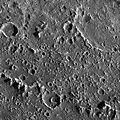Communauté • Livre d'or
 Actualités, astuces, interview... Venez lire la gazette de ce printemps de Vikidia !
Actualités, astuces, interview... Venez lire la gazette de ce printemps de Vikidia ! 
Fichier:Callisto terrain.jpg
Aller à la navigation
Aller à la recherche


Taille de cet aperçu : 600 × 599 pixels. Autres résolutions : 240 × 240 pixels | 481 × 480 pixels.
Fichier d’origine (800 × 799 pixels, taille du fichier : 185 kio, type MIME : image/jpeg)
Historique du fichier
Cliquer sur une date et heure pour voir le fichier tel qu'il était à ce moment-là.
| Date et heure | Vignette | Dimensions | Utilisateur | Commentaire | |
|---|---|---|---|---|---|
| Actuel | 1 avril 2005 à 08:18 |  | 800 × 799 (185 kio) | wikimediacommons>Smartech~commonswiki | {{PD-USGov-NASA}} Made by Galileo Spacecraft, downloaded from NASA website. In public domain |
Utilisation du fichier
La page suivante utilise ce fichier :

